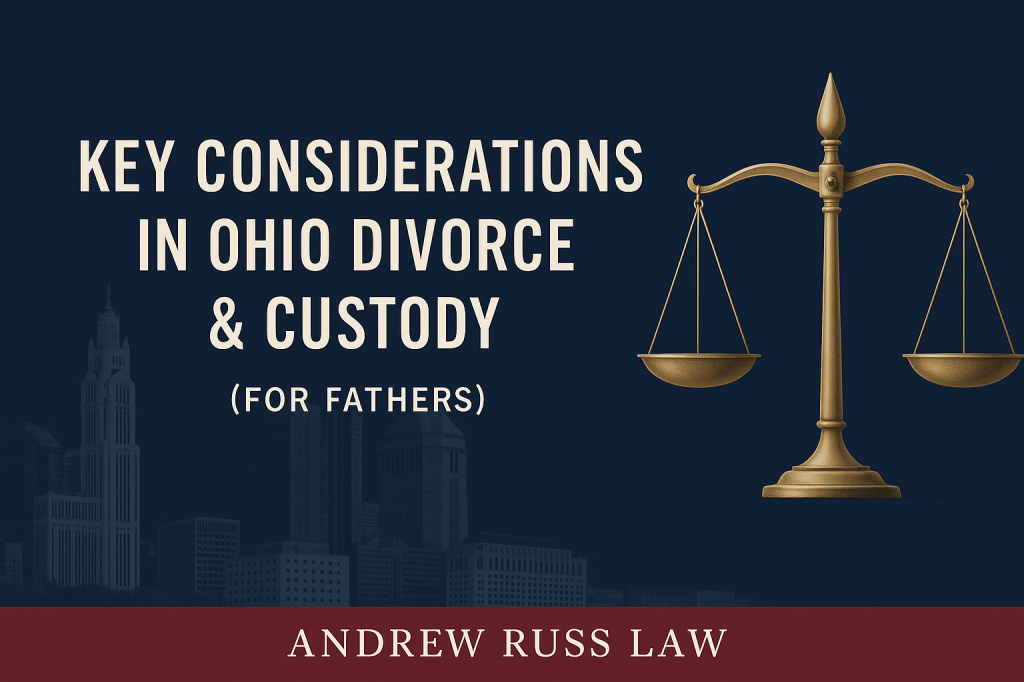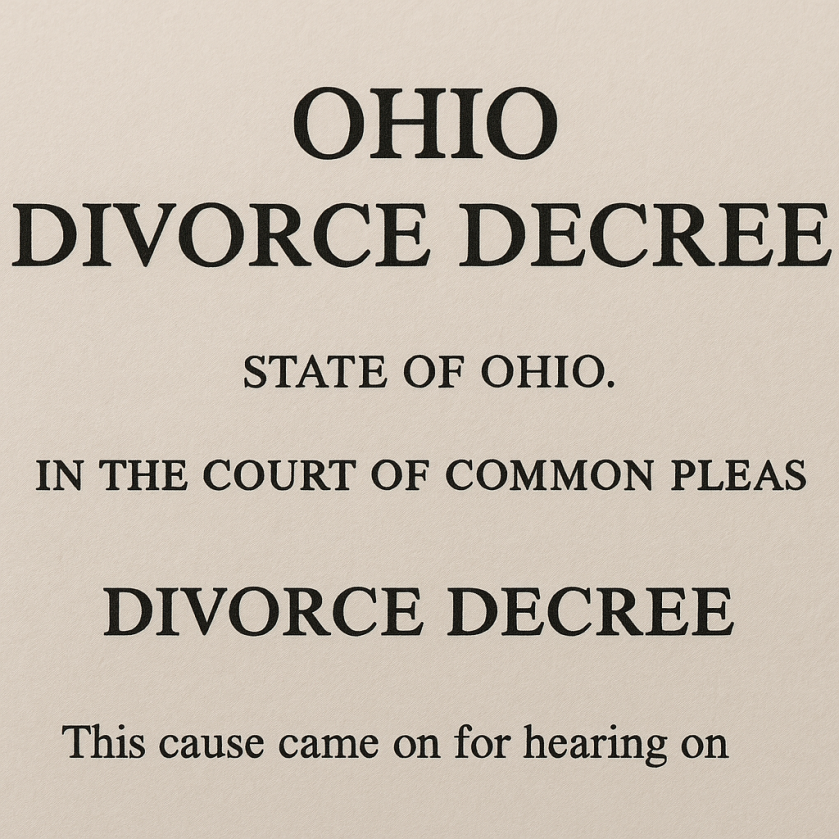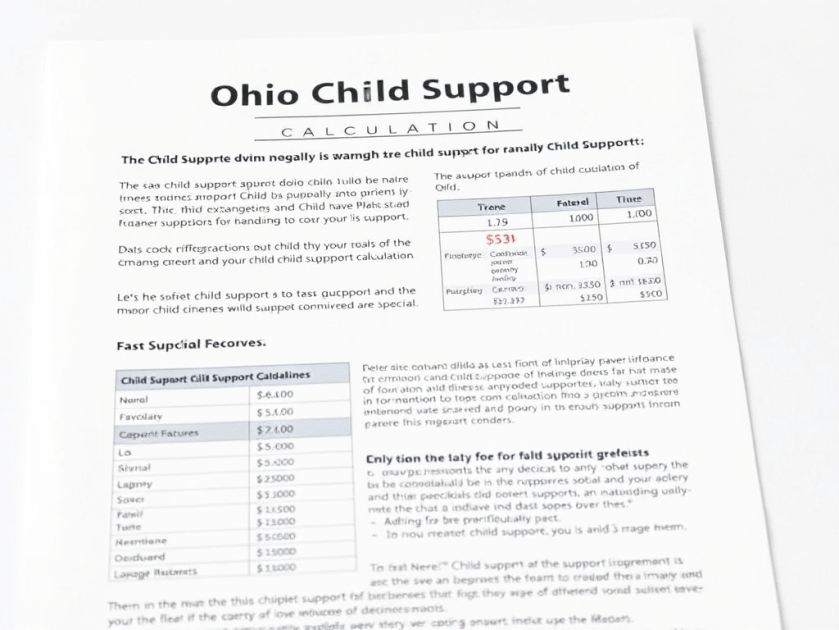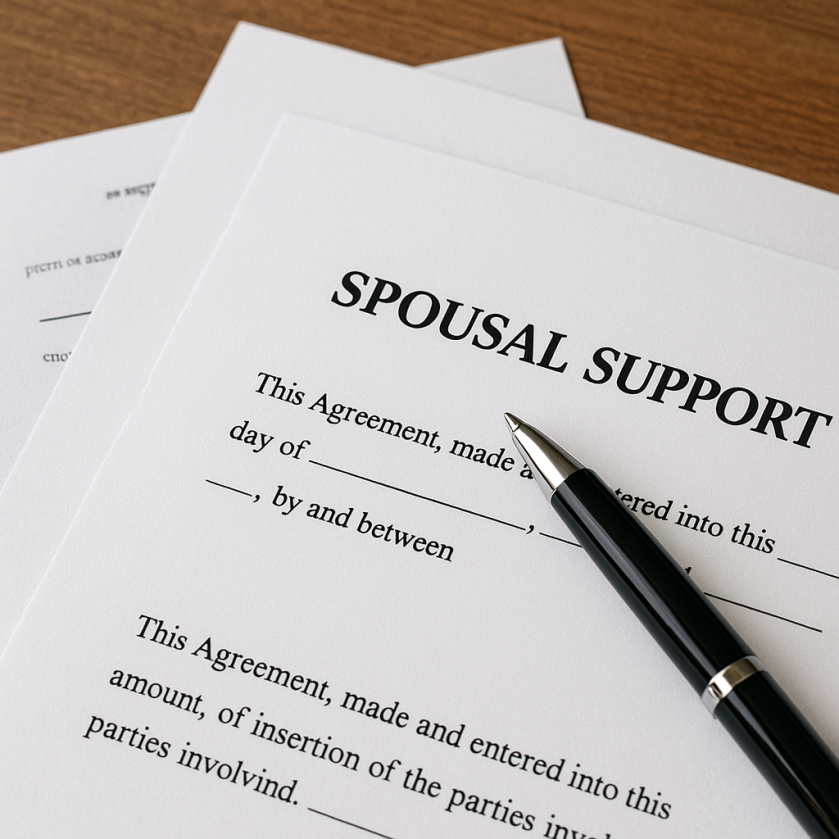Key Considerations in Ohio Divorce and Custody Cases
- Sep 2
- 7 min read
By Attorney Andrew Russ, Columbus Ohio custody and divorce attorney for men
Ohio Divorce & Custody Considerations | Andrew Russ Law
An overview of Ohio divorce, custody, support, and property rules from a Columbus Ohio custody and divorce attorney for men.

Ohio family cases involve several interlocking issues—how a marriage ends, where the case is heard, interim arrangements while a case is pending, how parental rights and responsibilities are determined, and how money and property are treated under state law. The summary below outlines the legal framework commonly applied in Franklin County and throughout Ohio, with focus areas relevant to fathers seeking clear, neutral information from a Columbus Ohio custody and divorce attorney for men, Attorney Andrew Russ.

1) Paths to Ending a Marriage in Ohio: Dissolution vs. Divorce
Dissolution of Marriage is a joint filing in which spouses submit a signed separation agreement covering all issues—parental rights and responsibilities, parenting time, child support, spousal support, and division of property and debts. Because all terms are resolved before filing, dissolution typically involves fewer court appearances and a shorter timetable.
Divorce is initiated when the parties have unresolved issues the court must decide. The process can include pleadings, discovery, temporary orders, pretrials, mediation, and—if needed—trial. In contested matters, the court will allocate parental rights and responsibilities, set child support and any spousal support, and equitably divide marital assets and debts.
2) Jurisdiction, Venue, and Local Practice
Ohio courts require proper jurisdiction over the marriage and, if children are involved, over custody matters. Venue is usually determined by county of residence—for many central Ohio cases, this is the Franklin County Court of Common Pleas, Domestic Relations and Juvenile Branch. Each county publishes local rules that govern filing formats, case flow, scheduling practices, mediation requirements, and parenting-time references. Local practice can influence timelines (e.g., how quickly temporary matters are heard) and the mechanics of how evidence is presented.
3) Temporary Orders During a Case
Early in a divorce, courts often issue temporary orders to maintain stability for the family while the case proceeds. Temporary orders can address:
Parenting time and temporary allocation of parental rights and responsibilities
Child support and temporary spousal support (where applicable)
Temporary possession of the marital residence and vehicles
Payment of ongoing household bills, health insurance, and uncovered medical costs
Temporary arrangements remain in effect until modified or replaced by the final decree. Courts frequently consider the temporary status quo when evaluating what has worked for the children.
4) The “Best Interest” Standard in Ohio Custody Law
When allocating parental rights and responsibilities or approving a shared parenting plan, Ohio courts apply the best interest of the child standard. Statutory factors include, in substance:
The child’s interaction and interrelationship with parents, siblings, and other significant persons
The child’s adjustment to home, school, and community
The mental and physical health of all persons involved
Each parent’s likelihood to honor parenting-time orders and facilitate the child’s relationship with the other parent
Any history of domestic violence, abuse, neglect, or substance misuse
Child support compliance and past interference with parenting time
The child’s wishes, if appropriately ascertained (e.g., in camera interview)
The impact of any proposed relocation
Outcomes vary by case; the court’s objective is a parenting arrangement that serves the child’s welfare and stability.
5) Shared Parenting and Sole Allocation
Shared Parenting (often informally called “joint custody”) is a court-approved plan in which both parents retain rights and responsibilities for major decisions affecting the child. Parenting time can be equal or unequal; the defining feature is the shared decision-making framework and a detailed plan governing routine schedules, exchanges, holidays, travel, school breaks, healthcare, communication, and dispute resolution.
Sole Allocation of Parental Rights and Responsibilities places primary decision-making authority with one parent, while the other parent exercises parenting time under an order or schedule.
Courts evaluate either model under the best-interest standard.

6) Guardian ad Litem (GAL)
In contested custody matters or where significant concerns are raised (e.g., safety, special needs, relocation), a Guardian ad Litem may be appointed to investigate and provide recommendations to the court. GALs typically interview parents and children (as appropriate), contact collateral sources (schools, daycare providers, counselors), and review relevant records. The GAL’s report is one component of the evidence the court may consider.

7) Child Support Framework
Ohio calculates child support using a statewide guideline that considers:
Each parent’s gross income (including wages, self-employment income, and certain other sources)
The number of children subject to the order
Credits and adjustments (e.g., health insurance premiums for the child, work-related childcare costs)
Certain parenting-time considerations recognized by statute and case law
Courts can deviate from the guideline amount if applying the guideline would be unjust or inappropriate and not in the child’s best interest. Potential grounds include extraordinary expenses, special needs, or significant parenting-time patterns. Orders typically allocate responsibility for health insurance coverage and unreimbursed medical expenses.
8) Property Division: Marital vs. Separate Property
Ohio follows equitable distribution. Property and debt acquired during the marriage are generally marital, subject to equitable division. Common categories include real estate equity attributable to marital contributions, retirement accumulations and vested benefits earned during the marriage, bank and investment accounts, vehicles, business interests developed during the marriage, and marital debt.
Separate property can include assets owned before the marriage, inheritances, and certain gifts to one spouse. When separate property has been commingled with marital property, courts may consider tracing to determine whether and to what extent separate interests remain. The equitable-distribution analysis also considers tax effects and practical division mechanisms (e.g., QDROs for retirement accounts).

9) Spousal Support (Alimony)
Ohio courts may award spousal support in amount and duration that the court deems appropriate, considering statutory factors such as:
The income and relative earning abilities of the parties
The ages and physical, mental, and emotional conditions of the parties
The retirement benefits of the parties
The duration of the marriage
The standard of living established during the marriage
The relative extent of education of the parties
The assets and liabilities of the parties, including any court-ordered payments
The contribution of each party to the education, training, or earning ability of the other
The time and expense necessary for the spouse seeking support to acquire education, training, or job experience
The tax consequences of an award
Any other factor the court expressly finds to be relevant and equitable
Awards are case-specific and can be modifiable or non-modifiable depending on the decree’s terms and statutory parameters.
10) Safety Considerations and Protection Orders
Ohio law provides civil protection orders (CPOs) to address domestic violence, menacing by stalking, and other qualifying conduct. In family cases, the existence or absence of a CPO can affect parenting-time decisions and exchange protocols. Allegations of abuse or neglect may prompt investigations or the appointment of a GAL. Courts examine the evidence presented and weigh safety alongside the objective of promoting healthy parent-child relationships.
11) Relocation and the UCCJEA
Interstate custody issues are governed by the Uniform Child Custody Jurisdiction and Enforcement Act (UCCJEA). Generally, the child’s home state—the state where the child has lived with a parent for at least six consecutive months immediately before a custody action—has jurisdiction to make initial custody determinations. When relocation is proposed after an order is in place, Ohio courts consider statutory factors and local rules addressing notice, the feasibility of revised schedules, and the child’s best interest. Orders from one state can be enforced in another under UCCJEA mechanisms.

12) Evidence and Case Records
Ohio domestic relations cases are evidence-driven. The record commonly includes:
School and daycare records, attendance reports, and communications
Medical and counseling records pertaining to the child, where permitted
Work schedules, pay stubs, tax returns, and employment records relevant to income
Financial account statements, retirement reports, and appraisals for property division
Communications between parents and third parties (texts, emails, parenting apps), when admissible
Police reports, incident logs, and protection-order filings, if applicable
Courts apply the rules of evidence, privilege, and confidentiality statutes when determining what may be considered.
13) Resolution Pathways: Negotiation, Mediation, and Trial
Ohio courts encourage alternative dispute resolution, including mediation, to resolve parenting and financial issues. Many cases reach settlement through negotiations memorialized in a separation agreement and, when minor children are involved, a shared parenting plan or parenting-time schedule. If full settlement is not achieved, unresolved issues proceed to trial, where the judge receives testimony and exhibits and issues findings and orders. The resulting decree or judgment entry governs the parties’ rights and responsibilities going forward.

14) Firm Overview: Andrew Russ Law
Andrew Russ Law represents men in central and southeast Ohio in matters involving divorce, dissolution, allocation of parental rights and responsibilities, parenting plans, child support, spousal support, property division, post-decree modifications, and related juvenile matters. The practice focuses on clear case organization, Ohio-specific procedure, and thorough presentation of facts within the best-interest and equitable-distribution frameworks. As a Columbus Ohio custody and divorce attorney for men, the firm handles matters in Franklin County and surrounding jurisdictions and coordinates with local rules and court processes throughout the case life cycle.

Legal Sources:
Ohio allocation of parental rights & shared parenting (R.C. 3109.04). (Ohio Laws)
Parenting time statute and scheduling (R.C. 3109.051). (Ohio Laws)
Presumptions and establishment of paternity (R.C. 3111.03). (Ohio Laws)
Paternity acknowledgment routes (Ohio Centralized Paternity Registry). (ODJFS)
Child support worksheet and definitions (R.C. 3119.022; 3119.01). (Ohio Laws)
andrewrusslaw.com Blog:
Disclaimer: This article provides general information and is not legal advice. Legal outcomes vary by facts and jurisdiction. Consult an attorney about your specific situation.
LINKS:
Disclaimer: The blog and articles provide general educational information, are not legal advice, and do not create an attorney/client relationship. Legal outcomes vary by facts and jurisdiction. Consult an attorney about your specific situation.







